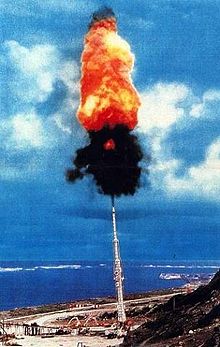
Back مشروع أبحاث الارتفعات الضخمة Arabic پرۆژەی ھارپ CKB High Altitude Research Project German Proyecto HARP Spanish HARP Finnish Projet HARP French HARP HE High Altitude Research Project Croatian Projeto HARP Portuguese Проект высотных исследований Russian

13°04′38″N 59°28′32″W / 13.077305695462803°N 59.47568766833662°W
Project HARP, for high altitude research project, was a joint venture of the United States Department of Defense and Canada's Department of National Defence created with the goal of studying ballistics of re-entry vehicles and collecting upper atmospheric data for research. Unlike conventional space launching methods that rely on rockets, HARP instead used very large guns to fire projectiles into the atmosphere at extremely high speeds.[1][2]
A 16-inch (41 cm) HARP gun operated by the U.S. Army's Ballistic Research Laboratory (now called the U.S. Army Research Laboratory) at Yuma Proving Ground currently holds the world record for the highest altitude that a gun-fired projectile has achieved: 180 kilometres (111.8 mi).[3][4]
- ^ Petrescu, Relly; Aversa, Raffaella; Akash, Bilal; Berto, Filippo; Apicella, Antonio; Petrescu, Florian (2017). "Project HARP". Journal of Aircraft and Spacecraft Technology. 1 (4): 249–257. doi:10.3844/jastsp.2017.249.257. SSRN 3092679.[predatory publisher]
- ^ Hanson, Joe (July 8, 2013). "Science Goes Ballistic: 8 Guns for Hunting Knowledge". Wired. Retrieved February 11, 2020.
- ^ Graf, Richard. "A Brief History of the HARP Project". Encyclopedia Astronautica. Archived from the original on August 20, 2016. Retrieved February 11, 2020.
- ^ Sterling, Bruce (September 1992). "Think of the Prestige". The Magazine of Fantasy and Science Fiction. Retrieved February 11, 2020.